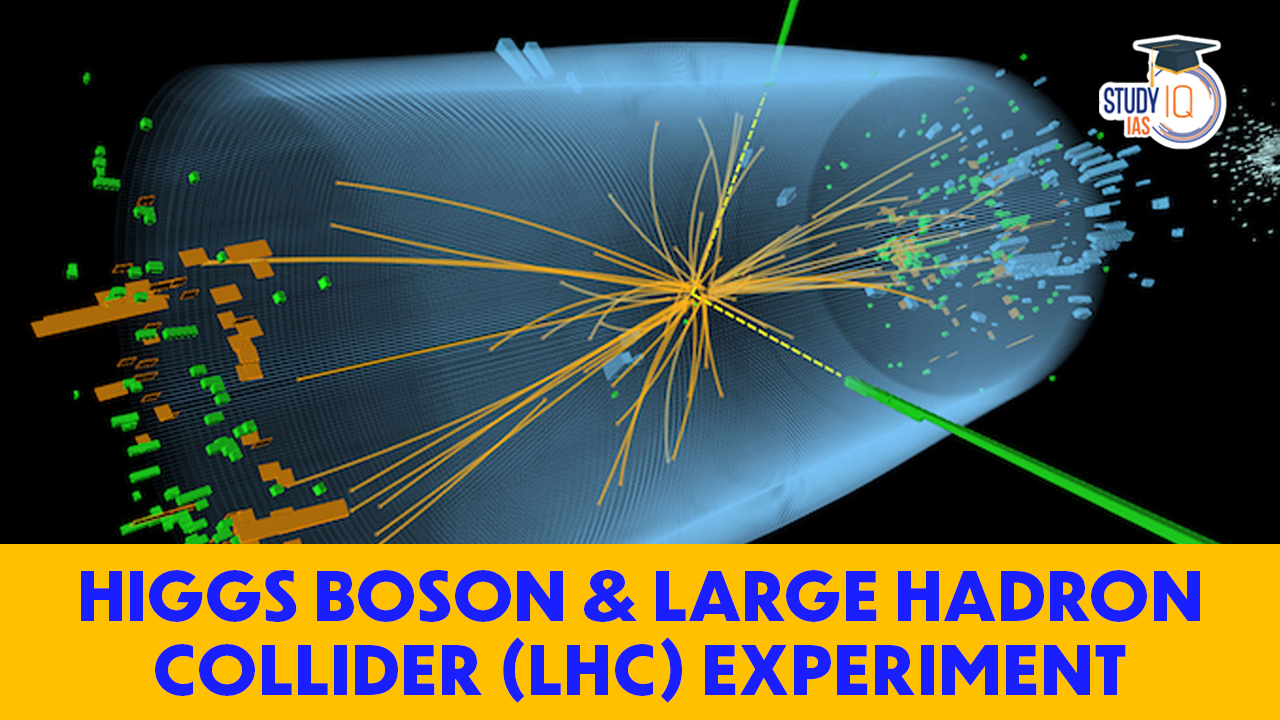Table of Contents
Context: Physicists working with the Large Hadron Collider (LHC) particle-smasher at CERN have detected a Higgs boson decaying into a Z boson particle and a photon.
Higgs Boson & Large Hadron Collider (LHC) Experiment Background
- The discovery of the Higgs boson at CERN’s Large Hadron Collider (LHC) in 2012 marked a significant milestone in particle physics.
- CERN, the European Organization for Nuclear Research, is one of the world’s largest and most respected centres for scientific research.
- Since then, the ATLAS and CMS collaborations have been investigating the properties of Higgs boson and searching to establish the different ways in which it is produced and decays into other particles.
- ATLAS and CMS are the two ‘general-purpose’ detectors at the LHC. They’re looking for any new particles or unknown physics which the LHC’s record-breakingly high energies might allow to observe for the first time.

What is Higgs Boson?
- Definition: Higgs Boson is the fundamental force-carrying subatomic particle associated with the Higgs field, a field that gives mass to other fundamental particles such as electrons.
- For example, when an electron interacts with the Higgs field, the effects it experiences are said to be due to its interaction with Higgs bosons.
- Higgs boson plays such a cardinal role in subatomic physics that it is sometimes referred to as the “God particle.”
- It is one of the 17 elementary particles that make up the Standard Model of particle physics.
- It was proposed in 1964 by Peter Higgs, François Englert, and four other theorists to explain why certain particles have mass.
- The particle was finally discovered on July 4, 2012, by researchers at the Large Hadron Collider (LHC).
- Implication: The stronger a particle’s interaction with the Higgs boson, the more mass it has.
- This is why electrons have a certain mass, protons have more of it, and neutrons have just a little bit more than protons.
- Photons, the particles of light, have no mass because they don’t interact with Higgs bosons.
- A Higgs boson can also interact with another Higgs boson, and this is how it is known that its mass is greater than that of protons or neutrons.
The Indian Touch
- The sub-atomic particle “boson” is named after Indian physicist Satyendra Nath Bose.
- His pioneering work in the field in the early 1920s changed the way particle physics has been studied.
- The work done by Bose and Albert Einstein laid the foundation for the discovery of the God particle.
- Bose specialized in mathematical physics and was a fellow of the Royal Society; he was awarded the Padma Vibhushan in 1954.
What is Large Hadron Collider (LHC)?
- It is the world’s largest and most powerful particle accelerator.
- It is located near Geneva, Switzerland, across the border of France and Switzerland.
- The LHC, built by CERN), is on the energy frontier of physics research, conducting experiments with highly energized particles.
- The LHC can reproduce the conditions that existed within a billionth of a second of the Big Bang.
- The colossal accelerator allows scientists to collide high-energy subatomic particles in a controlled environment and observe the interactions.
- One of the most significant LHC breakthroughs came in 2012 with the discovery of the Higgs Boson.
What is Standard Model of Particle Physics?
- It is scientists’ current best theory to describe the most basic building blocks of the universe.
- It explains how particles called quarks (which make up protons and neutrons) and leptons (which include electrons) make up all known matter.
- It also explains how force carrying particles, which belong to a broader group of bosons, influence the quarks and leptons.
- The Standard Model explains 3 of the 4 fundamental forces that govern the universe:
- Electromagnetism: Electromagnetism is carried by photons and involves the interaction of electric fields and magnetic fields.
- Strong Force: The strong force, which is carried by gluons, binds together atomic nuclei to make them stable.
- Weak Force: The weak force, carried by W and Z bosons, causes nuclear reactions that have powered the Sun and other stars for billions of years.
- Gravity: The fourth fundamental force is gravity, which is not adequately explained by the Standard Model.
- Limitation of Standard Model:
- The Higgs boson gives mass to quarks, charged leptons and the W and Z bosons. However, Standard Model can’t explain whether the Higgs boson also gives mass to neutrinos, which are ghostly particles that interact very rarely with other matter in the universe.
- This theory also can’t explain what dark matter is.
- Testing Predictions is Required: Testing the predictions of standard model will enable the physicists to find whether there are any cracks in the Model through which they can validate new theories of physics.
Higgs Boson-LHC Experiment and Its Significance
- The ATLAS and CMS teams have combined their data, collected between 2015 and 2018, to find the first evidence of the rare process in which the Higgs boson decays into a Z boson and a photon.
- Z boson is the electrically neutral carrier of the weak force.
- Photon is the carrier of the electromagnetic force.
- The Process: The decay of the Higgs boson into a Z boson and a photon is like that of decay into two photons.
- In these processes, the Higgs boson does not decay directly into these pairs of particles.
- Instead, the decays proceed via an intermediate “loop” of “virtual” particles that pop in and out of existence and cannot be directly detected.
- These virtual particles could include new, as yet undiscovered particles that interact with the Higgs boson.
- The LHC creates a Higgs boson by accelerating billions of highly energetic protons into a head-on collision, releasing a tremendous amount of energy that condenses into different particles.
- When a Higgs boson is created in this hot soup, it has a fleeting interaction with virtual particles that creates a Z boson and a photon.
- Importance: This Higgs boson decay could provide indirect evidence of the existence of particles beyond those predicted by the Standard Model of particle physics.

Relevance of New Findings
- As Higgs boson is heavy, it is an unstable particle that decays into lighter particles. It cannot be predicted which combination of particles it will decay into.
- However, the theory that describes the properties of fundamental particles has clearly predicted the probability that it will take a given path.
- The new finding of Higgs Boson decay has significantly increased the statistical precision and reach of searches at CERN.
- However, this significance is even now not high enough for the teams to claim a Higgs boson decayed to a Z boson and a photon with 100% certainty, reflecting the rarity of the decay pathway.


 Bharat Bandh 9 July 2025: Over 25 Crore ...
Bharat Bandh 9 July 2025: Over 25 Crore ...
 UPPSC Mains Question Paper 2025: Downloa...
UPPSC Mains Question Paper 2025: Downloa...
 Sukhoi Su-57: Will India Choose Russia�...
Sukhoi Su-57: Will India Choose Russia�...





















